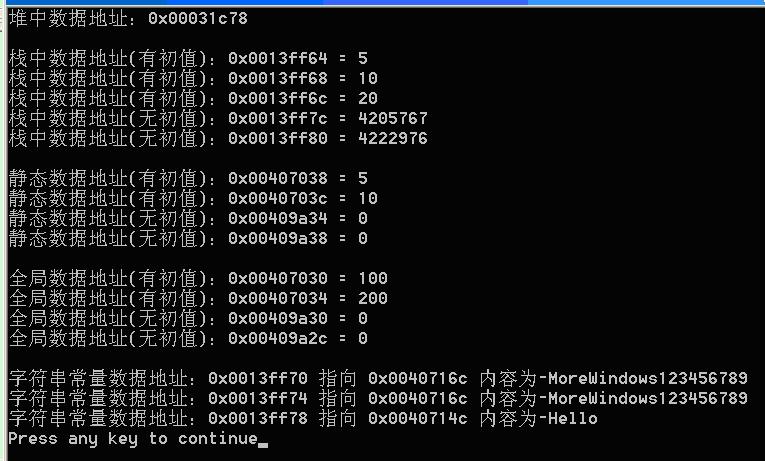各种变量在内存中的分布![]()
1栈 - 有编译器自动分配释放
2堆 - 一般由程序员分配释放,若程序员不释放,程序结束时可能由OS回收
3全局区(静态区),全局变量和静态变量的存储是放在一块的,初始化的全局变量和静态变量在一块区域,未初始化的全局变量和未初始化的静态变量在相邻的另一块区域。程序结束释放。
4另外还有一个专门放常量的地方。 - 程序结束释放
在函数体中定义的变量通常是在栈上,用malloc, calloc, realloc等分配内存的函数分配得到的就是在堆上。在所有函数体外定义的是全局量,加了static修饰符后不管在哪里都存放在全局区(静态区),在所有函数体外定义的static变量表示在该文件中有效,不能extern到别的文件用,在函数体内定义的static表示只在该函数体内有效。另外,函数中的 "adgfdf "这样的字符串存放在常量区。
比如:
int a = 0; 全局初始化区
char *p1; 全局未初始化区
main()
{
int b; 栈
char s[] = "abc ";栈
char *p2; 栈
char *p3 = "123456 "; 123456\0在常量区,p3在栈上。
static int c =0; 全局(静态)初始化区
p1 = (char *)malloc(10);
p2 = (char *)malloc(20);
分配得来得10和20字节的区域就在堆区。
strcpy(p1, "123456 "); 123456\0放在常量区,编译器可能会将它与p3所指向的 "12345
6 "优化成一块。
}
测试程序:
- #include
<stdio.h> - #include
<malloc.h> - int
g_i = 100; - int
g_j = 200; - int
g_k, g_h; - int
main() - {
-
const int MAXN = 100; -
int *p = (int*)malloc(MAXN * sizeof(int)); -
static int s_i = 5; -
static int s_j = 10; -
static int s_k; -
static int s_h; -
int i = 5; -
int j = 10; -
int k = 20; -
int f, h; -
char *pstr1 = "MoreWindows123456789"; -
char *pstr2 = "MoreWindows123456789"; -
char *pstr3 = "Hello"; -
-
-
printf("堆中数据地址:0xx\n", p); -
-
putchar('\n'); -
printf("栈中数据地址(有初值):0xx = %d\n", &i, i); -
printf("栈中数据地址(有初值):0xx = %d\n", &j, j); -
printf("栈中数据地址(有初值):0xx = %d\n", &k, k); -
printf("栈中数据地址(无初值):0xx = %d\n", &f, f); -
printf("栈中数据地址(无初值):0xx = %d\n", &h, h); -
-
putchar('\n'); -
printf("静态数据地址(有初值):0xx = %d\n", &s_i, s_i); -
printf("静态数据地址(有初值):0xx = %d\n", &s_j, s_j); -
printf("静态数据地址(无初值):0xx = %d\n", &s_k, s_k); -
printf("静态数据地址(无初值):0xx = %d\n", &s_h, s_h); -
-
putchar('\n'); -
printf("全局数据地址(有初值):0xx = %d\n", &g_i, g_i); -
printf("全局数据地址(有初值):0xx = %d\n", &g_j, g_j); -
printf("全局数据地址(无初值):0xx = %d\n", &g_k, g_k); -
printf("全局数据地址(无初值):0xx = %d\n", &g_h, g_h); -
-
putchar('\n'); -
printf("字符串常量数据地址:0xx 指向 0xx 内容为-%s\n", &pstr1, pstr1, pstr1); -
printf("字符串常量数据地址:0xx 指向 0xx 内容为-%s\n", &pstr2, pstr2, pstr2); -
printf("字符串常量数据地址:0xx 指向 0xx 内容为-%s\n", &pstr3, pstr3, pstr3); -
free(p); -
return 0; - }
运行结果(Release版本,XP系统)如下:

可以看出:
1.
2.
3.
4.
上面程序全在一个主函数中,下面增加函数调用,看看函数的参数和函数中变量会分配在什么地方。
程序如下:
- #include
<stdio.h> - void
fun(int i) - {
-
int j = i; -
static int s_i = 100; -
static int s_j; -
-
printf("子函数的参数: 0x%p = %d\n", &i, i); -
printf("子函数 栈中数据地址: 0x%p = %d\n", &j, j); -
printf("子函数 静态数据地址(有初值): 0x%p = %d\n", &s_i, s_i); -
printf("子函数 静态数据地址(无初值): 0x%p = %d\n", &s_j, s_j); - }
- int
main() - {
-
int i = 5; -
static int s_i = 100; -
static int s_j; -
-
printf("主函数 栈中数据地址: 0x%p = %d\n", &i, i); -
printf("主函数 静态数据地址(有初值): 0x%p = %d\n", &s_i, s_i); -
printf("子函数 静态数据地址(无初值): 0x%p = %d\n", &s_j, s_j); -
putchar('\n'); -
-
fun(i); -
return 0; - }
运行结果如下:

可以看出,主函数中栈的地址都要高于子函数中参数及栈地址,证明了栈的伸展方向是由高地址向低地址扩展的。主函数和子函数中静态数据的地址也是相邻的,说明程序会将已初始化的全局变量和表态变量分配在一起,未初始化的全局变量和表态变量分配在另一起。






















 1583
1583

 被折叠的 条评论
为什么被折叠?
被折叠的 条评论
为什么被折叠?








